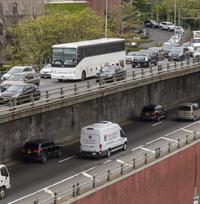Kansas University professor of civil, environmental & architectural engineering Caroline Bennett will serve as the primary investigator on a US$258,165, 34-month Federal Highway Administration (FHWA) grant aimed at the development of improved detailing in steel bridges to prevent constraint-induced fractures. It is one of three bridge-related studies at Kansas University that have been granted FHWA funding.
“This is a specific type of fracture that can happen in fabricated steel components when you have detailing that produces something we call ‘constraint’ — when the structure can’t deform freely, localised stresses can build up such that the structure is not able to deform in the way that we expect as engineers. This can cause a brittle fracture, and that can bring a structure down,” she said. “The type of detailing practices that might lead to this really aren’t well understood, and we’ve had a couple of bridge failures over the last few decades that have been attributed to constraint-induced fracture.”
She pointed to Milwaukee’s Hoan bridge failure in 2000 as a classic example of constraint-induced fracture, when three girders of the 3km-long bridge fractured with no evidence of prior fatigue crack development.
“It was a miracle that no one died because of that failure,” Bennett said. “We know that was caused by constraint-induced fracture, but in terms of avoiding that type of failure in different details and on a large scale, the advice engineers are given is pretty imprecise. Our job is to characterise constraint-induced fracture to help engineers detail and design structures in a way where this does not happen, and that we can more reliably look at existing structures and figure out whether they’re at an elevated risk of experiencing constraint-induced fracture. Also, we’ll equip engineers to figure out how to how to deal with this risk and retrofit a structure should it become important.”
Bennett, with fellow investigators and students from the School of Engineering, will use computational simulations and the university’s West Campus Structural Testing Laboratory to characterise the susceptibility of structural stiffener details in steel bridges to constraint-induced fracture, including thick bearing stiffeners, different constraint-relief gap distances between intersecting structural components and continuous welding at the intersection of the flange-web-connection plate.
A second FHWA grant, worth US$112,413, will see Bennett leading a 22-month study to investigate how to improve university curricula for graduate students studying design of bridges across the nation. According to Bennett and her co-investigators, “universities have reduced credit hours needed for a degree in structural engineering to focus on ‘the basics’ of a graduate education, often excluding bridge engineering”.
At the same time, codes and specifications governing bridge engineering practice have become increasingly complex, according to the researchers.
“We want to take stock of what is happening in the nation regarding existing university education of engineers who might become bridge engineers — and also take stock of what continuing education currently looks like within bridge engineering — and ask, ‘What can we be doing better?'” Bennett said. “A lot of people who become competent bridge engineers require significant on-the-job training because they have not had a lot of formal education directly mapping to bridges. So, how can we better prepare and support people who are going to be working as bridge engineers?”
Through a review of curricula, surveys and direct discussions with engineering faculty across the nation, Bennett and her co-investigators plan to determine the state of engineering education for bridge design.
“We can provide a really solid capture of what is happening and where the gaps are as well as pathways for people to improve continuing education and engineering education in university settings,” Bennett said. “We’ll provide guidance on how to implement a backwards design process in both settings.”
William Collins, associate professor of civil, environmental & architectural engineering, serves as a co-investigator on both grants headed by Bennett. In addition, Collins will lead the Kansas University portion of a US$130,000, 22-month FHWA grant headed by Modjeski & Masters. The investigation will assess effectiveness of ultra-high toughness (UHT) steel within steel bridge members to improve structural reliability for the fracture limit-state, potentially deeming a fracture-critical designation unnecessary.
“The idea of preventing fracture is a big deal in civil infrastructure, especially for bridges,” Collins said. “When exposed to colder temperatures, steel structures are more susceptible to fracture-related failures. This is not typically a concern in buildings because buildings aren’t exposed to the elements like bridges are. In addition to these projects, Caroline and I do a lot of work examining different ways to monitor and inspect for fatigue and cracks. Rather than the design or inspection aspects of controlling fracture, this third project is focused on the material side of things.”
According to Collins, steel-making capabilities have greatly improved in the past few decades, but steel-bridge designs don’t make the best use of steel’s enhanced performance.
“If we can take advantage of some of that increased fracture toughness we have right now in our steels, we can potentially save money on the inspection and maintenance side of things,” Collins said. “This project is looking at some more advanced steels used in other industries. Steels to build towers for wind turbines, for example, often meet a lot of the criteria we have for bridge steels, but they come with improved material properties — so we may pay a little bit more for that on the front end, but we could save money on the back end with fewer expensive inspections over the 50-, 75- or 100-year life of a bridge.”




